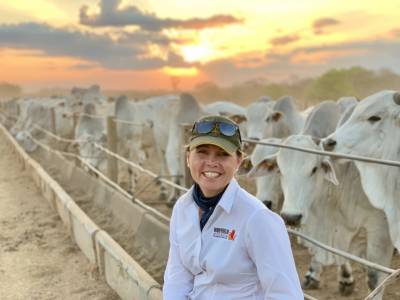
Rebecca aims to breed profitable cattle to thrive in northern Australia, while addressing social concerns and environmental signals. Rebecca travelled to 14 countries during 2019 as part of her research to discover how to further optimise her herds genetic progress in traits of importance, especially those that drive profit and are not recognisable by eye, eg fertility, feed efficiency, carcass yield and eating quality.
Growing up working at Boogal Cattle, Monto QLD, with her family, Rebecca was curious how to select cattle with only visual tools in the hard to measure traits. In addition, time spent away at university, as a beef consumer meant Rebecca experienced a wide variation in the eating quality of beef. Rebecca left the family’s seedstock business and spent 15 years co-managing a commercial beef breeding and fattening business. During this experience, many herd management changes of the Bos indicus breeders resulted in fewer inputs and more calves from the same number of cows, along with increased kilograms/ha and improvement in the Meat Standards Australia (MSA) index or eating quality. In short, more profit from management change. Rebecca learnt first-hand that the combination of environmental and herd management changes had a big impact on production and profit.
While these improvements were satisfying, Rebecca knew that fertility and eating quality could be further improved with genetics. The difficulty encountered was sourcing bulls for the above-mentioned ‘hard to measure’ traits (HTMTs) that would meet or supersede management improvement and breeding objectives. The purchase of bulls was a larger annual expense, yet these purchases had previously been made visually, as no breeding values were available and therefore with little attention to return on investment. Bull buying seemed to be a gamble.
We are driven to question things, when motivated by a greater need or want. Does Jan Bonsma’s dictum of a ‘man must measure a epitomise our future road in Australian beef? Hence, Rebecca decided to apply for a Nuffield Scholarship to research world best practices in selecting and breeding for profit.
The key aspects of animal breeding were summarised concisely at the beginning of the authors research journey, at the Animal Genetics and Breeding Unit (AGBU), Armidale Australia, into this basic formula (Johnson, Wolcott, & Walmsley, 2019).
Phenotype = Genotype + Environment
Phenotype is the animal. The measurable and visual traits, or the expression of the genes that are distributed to the progeny, as a result of the sire and dam pairing.
Genotype refers to the DNA of an animal, or the distribution of genes from relatives.
Environment is the effect that the quality of pasture or nutrition, climate or health status has on the chosen genetics, or ‘E’ for everything else.
Animal breeding can be described as the management of both the genetic and non-genetic differences to breed a desired animal. (Johnson, Wolcott, & Walmsley, 2019).
The introduction of genetically superior bulls is one of the quickest ways to achieve change in a beef cattle herd. As genetic change is permanent and cumulative, the effect of a single bull’s genetics will remain in a herd through retained breeding females and their descendants for decades. Therefore, ensuring that each new sire has a positive genetic and profitable impact in the herd is vital. (BREEDPLAN, 2020)
In the author’s visits to production enterprises around the world, extraordinary genetic gains were observed in beef and other animal species. Commonalities identified were:
a) clearly defined ‘long-term’ breeding objectives
b) ongoing animal measurement (collection of phenotypes)
c) genotyping
d) genetic evaluation
e) and the use of all the selection tools available
Globally it was noted that leading livestock operations were focussed on breeding animals that not only achieved profitability yet fulfilled environmental and consumer expectation goals.
Currently there are many genetic selection tools available in the Australian cattle breeders toolbox. They could be summarised as visual selection, pedigree, physical measurement, genotyping and genetic analysis. BREEDPLAN was released for beef industry use 36 years ago, with over 70% of southern Australian bulls offered for sale supported by EBVs, whereas in northern Australia only 15% of sale bulls are accompanied by EBVs. Therefore, it is not surprising that, on average, the current rate of genetic progress in British breeds is just over $4/cow joined/year, compared to the Northern Australia’s rate of genetic progress of just $1/cow joined/year (Banks, 2019).
Increased measurement of northern cattle would increase our range of selection tools in the genetic toolbox. Selection is never based on one attribute alone. As Mark Gardiner from Gardiner Angus, Kansas USA states, ‘Why not select the bulls that will make you the most money?’ and he adds ‘Just use ALL the tools available!’ (Gardiner, 2019).
Of the national beef herd, 64% is located in northern Australia (Queensland, Northern Territory and northern Western Australia), and the remaining 36% inhabit southern Australia (ABARES, 2019).
Figure 1: MLA Beef Regions – northern and southern Australia (ABARES, 2019)
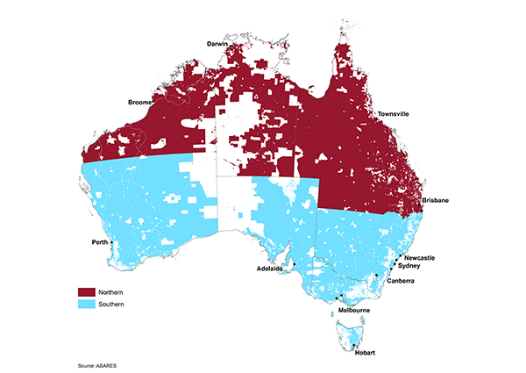
Beef CRC results showing low weaning rates of 62 and 78% for Brahman and Tropical Composite, respectively, suggests opportunity to improve reproduction rates, thus productivity and profitability for northern beef breeders (CRC, 2003). Northern Australia can benefit from improving reproductive rate, sale weight and decreasing mortality, within the limitations of carrying capacity and available markets as shown in Table 1 below (Holmes & McLean, 2017). These authors also found that the top 25% of producers in the northern region, despite these challenges, have a significantly higher Earnings Before Interest and Tax (EBIT).
Table 1: Potential for improvement in northern Australia (Holmes & McLean, 2017)

The differences between northern and southern Australian beef operations range from climatic differences, pasture quality, scale and proximity to markets. All are contributing factors to the moderate and low results observed (MLA, 2019).
Australian beef producers operate in varying environments. However, there is potential to manage what we can control. The Australian Beef Report 2017 stated two barriers to profit in the beef industry are Operating scale (Number of animal units) and Operating efficiency. Assuming an adequate operating scale and number of animal units, three factors that influence operating efficiencies and are able to be managed by producers:
- Grazing land management
- Herd management
- Genetics (Holmes & McLean, 2017)
While the importance of grazing land and herd management in overall business profitability can never be underestimated, the authors global research showed how focussed genetic selection has played a role to complement existing best practice management and improve overall business profit and sustainability.
Genotyping
In Australia, genotyping tests became available as early as 1963, then in 1993 with micro satellite technology and more recently single nucleotide polymorphism (SNP) technology in 2011–13; however, adoption has increased significantly since 2018 (Neogen, 2021). Genotyping offered diagnostic results for parent verification or genetic disorders in early years. Nowadays with sufficient phenotypes, genomics can evaluate the genetics of an animal by combining information on pedigree, phenotype and genotype to produce a Breeding Value (BV). Cattle that have never been measured before, now can gain a breeding value from genomics.
Although easy to collect and seen to be a ‘silver bullet’ for northern Australias lack of breeding values, genomic evaluations cannot exist without the physical measurements with which to compare. Utilising one platform of measurement for genetic evaluation is not as accurate as combining all platforms; phenotype, pedigree and genotype (Bertram, 2018) (see Figure 2).
Figure 2: Increasing the accuracy of EBVs with multiple sources of information (Bertram, 2018)
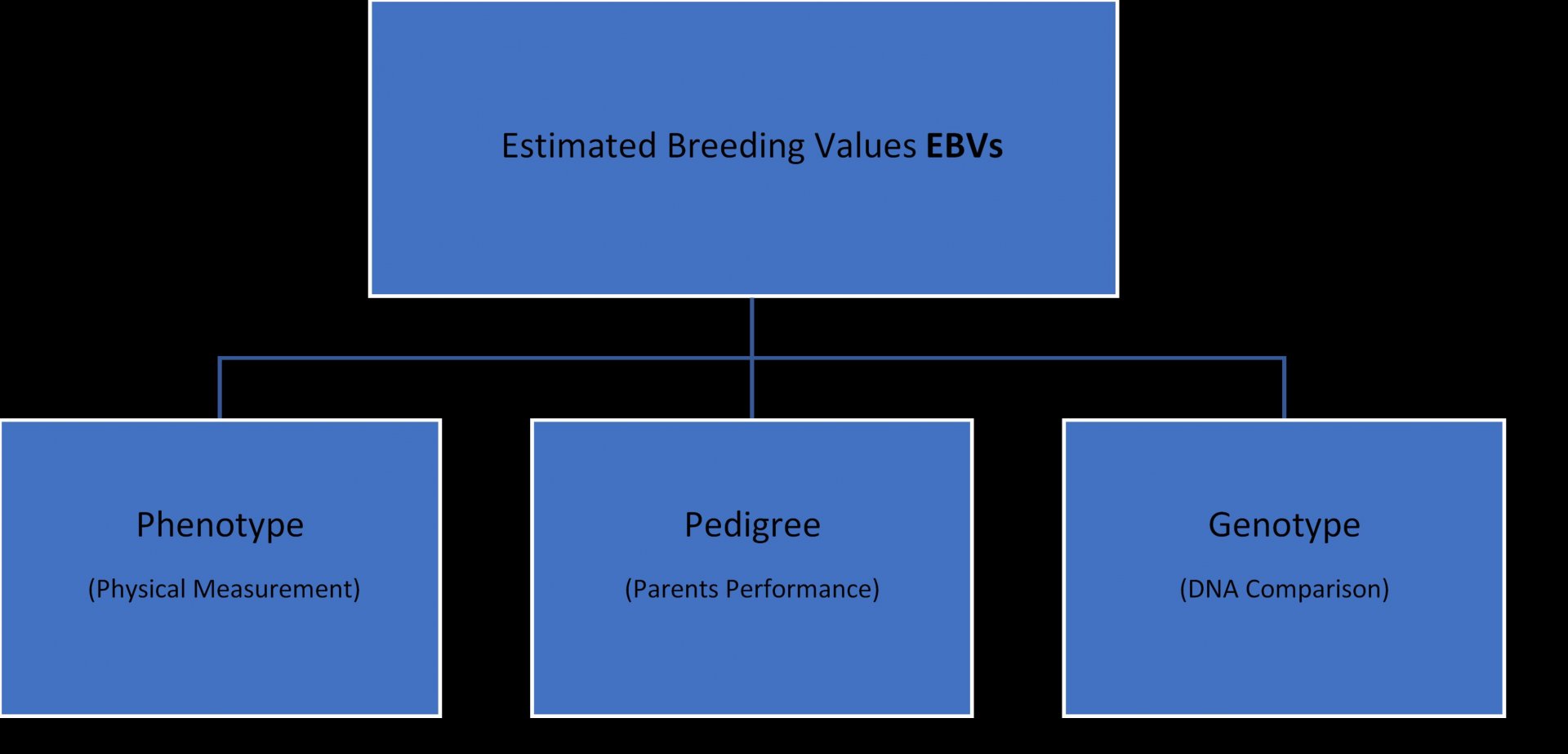
Phenotyping
Currently the collection of phenotypes are difficult and expensive to record in the extensive and rough terrain that northern Australias cattle exist. It is hoped that innovation and adoption of new technology observed globally may help to increase the phenotype collection in northern Australia. The integration of modern technology for animal measurement was observed at dairies, research stations and universities globally, mostly in intensive situations.
The collection of animal data observed, could be divided into the manual or automatic collection of phenotype. The main types of automatic measurement observed were:
- Individual animal management and monitoring e.g. On-animal sensors collecting Behaviour, State and Location
- Paddock based management and monitoring systems e.g. Walk Over Weighing (WOW), Auto-drafting
Date of birth is a trait that is difficult and time consuming for seedstock producers to capture in the extensive paddocks of Northern Australia. However, to be 7 days out on date of birth results in a 4% inaccuracy on the 200-day weight breeding value (Hudson, 2020) and distorts the accuracy of other breeding values in genetic analysis. The following are some alternatives seen both globally and in Australia to the current manual data collection of this trait.
Calf Alert is a telemetric device placed in the vagina of a pregnant cow with 100% tested retention for at least 6 months. It is capable of identifying the time and location of calving events and alerting the producer via SMS or computer messaging. (Stephen, D Menzies, Patison, Corbet, & Norman, 2019) Raoul Boughton of University of Florida had also tested a similar product, VIT or vaginal implant transmitters (Broughton, 2019).
Figure 3: Telemetric Calf Alert Device in the authors hand (Comiskey, 2019)
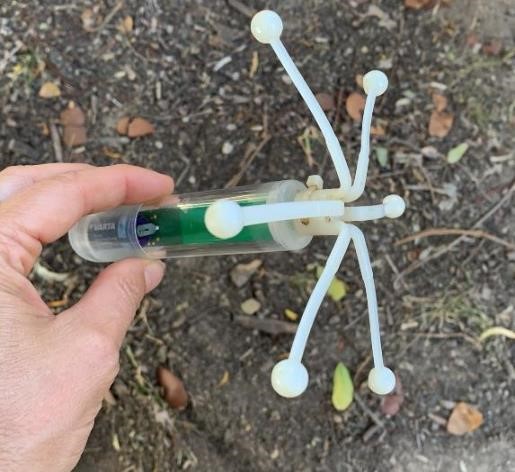
CQU Precision Livestock Management technology integrates on-farm walk-over-weighing systems (WOW), low-band width data transmission technology and sophisticated analysis systems to deliver real time information about individual animals and infrastructure direct to a mobile app. The project aims to record several phenotypic measurements for inclusion in national genetic evaluation programs. It will also enable commercial producers to manage individual animals with targeted nutritional supplementation, temporal sequencing for age of puberty with cameras and video recognition etc. The date of birth for more than 120 calves has been successfully captured at AgForce’s Belmont Research Station, QLD, Australia. For more information: https://www.datamuster.net.au/
Figure 4: Remote Australian WOW at a water yard (Central Station, 2020)
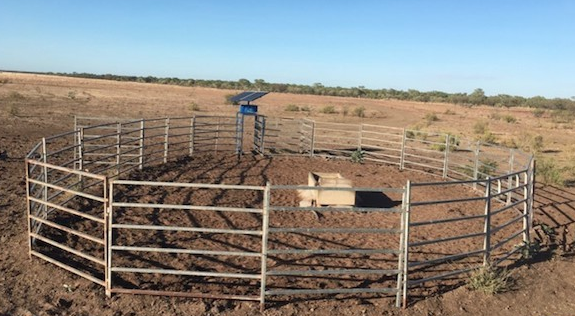
However, easier than the above mentioned and part of routine breeder management may be considering the use of ultrasound foetal aging at pregnancy diagnosis to ascertain date of birth for genetic analysis.
Age at puberty and lactation anoestrus interval are some of many HTMTs that contribute to the complex profit driving trait of fertility. Research performed in the Cooperative Research Centre (CRC) for Beef illustrated the genetic variation in age at puberty as shown in Table 2 below, (BREEDPLAN, 2020). Currently Australian research projects are measuring by internal ultrasound to provide information to incorporate fertility information as breeding values for tropical breeds and across breeds. Developments were observed to measure oestrus with automatic modern technology such as individual collars and tags, promising to replace the current manual ovarian scanning for northern beef fertility phenotyping.
Table 2 illustrates the huge genetic variation that exists in our northern cattle herd. The future is being able to have the tools to select the genetics that suit an operations breeding objective. Many other novel traits and applications of modern technology were observed, however just these two key profit driving traits have been covered for the BCBC digest.
Table 2: Mean and range for all heifers at age of puberty trait and age at 1st CL (TBTS, 2020)
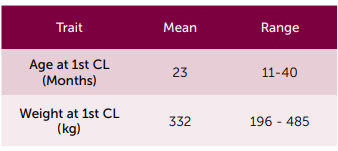
Conclusion
Given the recent surge of interest in genotyping in Australian Beef, this study was to learn what modern technology can offer our industry, especially in optimising selection. Although cattle with no prior measurement could gain breeding values through genomics, the authors investigation uncovered the importance of innovation around the collection of phenotype measurements. Phenotypes are needed to support genotyping. Hopefully modern technology can increase the amount of current measurement and change the paradigm that measurement is difficult in northern Australia, as without continual physical animal measurement, genomics will be dust (Hayes, 2018).
In addition to establishing an efficient management template for grazing land and herd management, Australian beef producers should seek to optimise their selection and profitability by utilising ALL the genetic selection tools available. It was observed in many global examples, if it can be measured, it can be managed.
References
ABARES. (2019, December 18). Australian Government. Retrieved from Department of Agriculture – Australian Bureau of Agricultural and Resource Economics and Sciences: https://www.agriculture.gov.au/abares/researchtopics/surveys#beef-data-and-other-resources
Banks, R. (2019, July/August). Mr. MLA Feedback, pp. 2–3. Breedplan. (2020, Jan 7).
Breedplan. Retrieved from ABRI :http://breedplan.une.edu.au/ tips/Maximising%20Genetic%20Improvement% 20in%20a%20Seedstock%20Beef%20 Breeding%20Enterprise.pdf
Bertram, J. (2018, July 9). (R. Comiskey, Interviewer)
Boughton, R. (2019, August 20). Dr (R. Comiskey, Interviewer)
Comiskey, R. (2019).
CRC, 2003
Gardiner, M. (2019, September 10). Gardiner Angus, Kansas USA. (R. Comiskey, Interviewer)
Hayes, D.B. (2018, September ). (R. Comiskey, Interviewer)
Holmes, P. and McLean, I. (2017). Australian Beef Report. Retrieved from www.bushagri.com.au
Hudson, S. (2020, July). (R. Burnham, Interviewer)
Johnson, D., Wolcott, M. and Walmsley, B. (2019, July 22). Animals Genetics and Breeding Unit. (R. Comiskey, Interviewer)
MLA. (2019). Global Snapshot Beef. Retrieved from https://www.mla.com.au/globalassets/ mla-corporate/prices—markets/documents/os-markets/export-statistics/jan-2019- snapshots/global-beef-snapshot-jan2019.pdf
Neogen, (2020, 2021). (R. Burnham, Interviewer)
Pryce, Jennie. (2020) Genetics Australia 2020 Webinar – Session 6
Stephen, C., D Menzies, D. S., Patison, K., Corbet, N. and Norman, S. (2019). Telemetric monitoring of calving using a novel calf alert device. Clinical Theriogenology, Vol 11, No 3.
TBTS (2020) Tropical Breed Technical Services. http://tbts.une.edu.au/media/ 1062/variation_puberty.pd